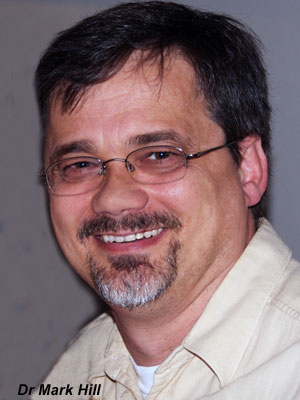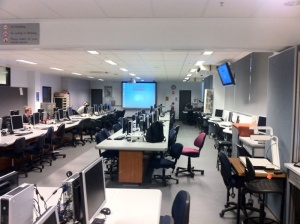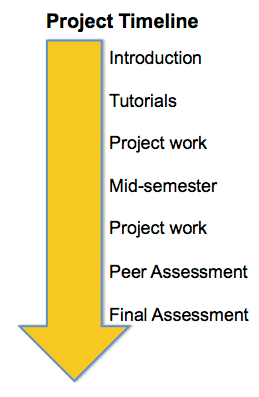Medicine Learning and Teaching Forum 2012 - Online Projects: Difference between revisions
| Line 224: | Line 224: | ||
|- | |- | ||
| [[File:Mark_Hill.jpg|eft|50px]] | | [[File:Mark_Hill.jpg|eft|50px]] | ||
At about the 75% stage of the project an important process in learning occurs, this is when individual students assess other student groups.The assessment is short | At about the 75% stage of the project an important process in learning occurs, this is when individual students assess other student groups.The assessment is short requiring "only prepare 3-5 paragraphs/project". In the previous lab the course coordinator had carried out a similar brief verbal assessment overview of how each project was developing. In the lab where the assessment is set the students are also given advice as to how to provide a "balanced assessment", including both strengths and weaknesses (positive and negative) in their comments. The entire class comments are made available to each group (on the discussion page of each project). Importantly all students have now read all projects and can see what their peers have done in preparing other projects and how their own project compares. This process also does some of the initial critical assessment/feedback that the coordinator would have previously done. | ||
The individual process though requires: | |||
# Each student to critically read all the other projects. | |||
# Apply the final assessment criteria (see the table below or [[ANAT2341_2012_Students#Group_Assessment_Criteria|student advice]]). | |||
# Identify the main points that the project either addresses or does not address within the criteria. | |||
The group process requires: | |||
# Reading all the the individual assessment comments. | |||
# Collating the comments to identify what other students liked or disliked. | |||
# Make appropriate changes (or ignore) to their project before final submission for coordinator assessment. | |||
[[ANAT2341_Embryology_2012#Assessment|2012 Course Assessment]] | [[ANAT2341_Embryology_2012#Assessment|2012 Course Assessment]] | ||
| Line 230: | Line 242: | ||
2012 Students: [[ANAT2341_2012_Students|Embryology Students - see Lab 8 Assessment]] [http://php.med.unsw.edu.au/cellbiology/index.php?title=2012_Student Cell Biology Students - see Lab 9 Assessment] | 2012 Students: [[ANAT2341_2012_Students|Embryology Students - see Lab 8 Assessment]] [http://php.med.unsw.edu.au/cellbiology/index.php?title=2012_Student Cell Biology Students - see Lab 9 Assessment] | ||
|} | |||
{| class="wikitable collapsible collapsed" | |||
! Group Assessment Criteria | |||
|- | |||
| [[File:Mark_Hill.jpg|left|50px]] The assessment criteria was based upon those designed for the Medicine student Wikis. | |||
# The key points relating to the topic that your group allocated are clearly described. | |||
# The choice of content, headings and sub-headings, diagrams, tables, graphs show a good understanding of the topic area. | |||
# Content is correctly cited and referenced. | |||
# The wiki has an element of teaching at a peer level using the student's own innovative diagrams, tables or figures and/or using interesting examples or explanations. | |||
# Evidence of significant research relating to basic and applied sciences that goes beyond the formal teaching activities. | |||
# Relates the topic and content of the Wiki entry to learning aims of embryology. | |||
# Clearly reflects on editing/feedback from group peers and articulates how the Wiki could be improved (or not) based on peer comments/feedback. Demonstrates an ability to review own work when criticised in an open edited wiki format. Reflects on what was learned from the process of editing a peer's wiki. | |||
# Evaluates own performance and that of group peers to give a rounded summary of this wiki process in terms of group effort and achievement. | |||
# The content of the wiki should demonstrate to the reader that your group has researched adequately on this topic and covered the key areas necessary to inform your peers in their learning. | |||
# Develops and edits the wiki entries in accordance with the above guidelines. | |||
|} | |} | ||
Revision as of 05:39, 5 December 2012
Online Projects
Wednesday 7 December 2012 - Developing online student group project work.
- Group Project - Time to relax while you watch someone who cares do all the work. How to get a group to work?
Abstract
This presentation will discuss the experiences in developing small science student group projects (3 to 5 students) that are prepared online in an interactive manner throughout the semester. This group assessment item replaced a previous poster presentation project. This assessment has now been running for a number of years, and the current presentation will describe the pedagogy of this assessment as well as associated practical issues. Key practical issues discussed include: initial tutorials to train students, literature researching strategies, copyright issues, plagiarism and peer assessment.
Introduction
This assessment has now been running for a number of years, and the current presentation will describe the pedagogy of this assessment as well as how the iterations of these projects have allowed fine tuning of the "process".
- Pedagogically
- Collaboration - Communication - Responsibility - Teamwork.
- I see great value in designing group assessment items for students as this really tests their ability to work collaboratively and to determine their own strengths and weaknesses, as well as those of others, in a team environment.
- Please note that many students initially do not like this form of assessment, as it relies on them making to much of an "ongoing contribution" (more work than they intended) and they are also concerned about project "free riders" (academic plagiarism).
- In the past
- Designing group assessment items often involved working inside practical class times, or preparation of posters/talks on a specific topic either inside class times or with an option for some independent work outside those times.
- I have previously used both these techniques in designing course assessments.
- Currently
- I have designed a semester-long group assessment project that allows students an option to work together over an extended period researching topics that relate directly to the course goals.
- There are many different components to this project process, and given the limited time for my presentation, I will only be able to touch on a few key concepts outlined in the abstract.
- Note that there is also a Medicine online group assessment project, that works a little differently in structure from the model described here.
Further details and links are made available here for you to explore further in your own time, and I am always happy to respond to emailed questions.
--Mark Hill 11:32, 27 November 2012 (EST)
Project Design
- Students are introduced to group project in the first lecture when going through the course outline.
Project Timeline
Semester Weeks
- Week 2 - Introduction to assessment (group and individual), previous examples, topics, resources, plagiarism, student questions. Group design Online Assessment
- Week 3 - Project tutorials, referencing, referencing resources, copyright, adding an image, topic selection. Allocated groups ANAT2341 References
- Week 4 - Sub-headings, allocation of individual student work. How's the group working? Editing
- Week 5 - Topic concept area progress. Problems?
- Week 6 - Project work. Initial assessor feedback
- Week 7 - Project work. Pulling your weight?
- Week 8 - Project work. In-class presentations and assessor feedback.
- Week 9 - Peer assessment process.
- Week 10 - Project update in response to peer comments.
- Week 11 - Project locked to students. Individual student feedback on group.
- Week 12 - Final Assessment.
| Group Assessment Criteria |
|---|
The assessment criteria was based upon those designed for the Medicine student Wikis.
|
Practical Issues
Teams
| 1. Project Team Selection - co-ordinator. |
|---|
 I have tried several methods and suggest that each group need a group co-ordinator. This can be simply asking students to identify from a list of descriptions which best fits their character. Students identified as completing an online project in semester 1 can be distributed in semester 2 classes. (See Belbin Team Inventory) I have tried several methods and suggest that each group need a group co-ordinator. This can be simply asking students to identify from a list of descriptions which best fits their character. Students identified as completing an online project in semester 1 can be distributed in semester 2 classes. (See Belbin Team Inventory)
|
| 2. Project Team - which are working. | |
|---|---|
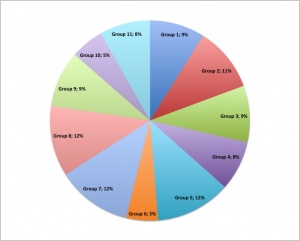
|
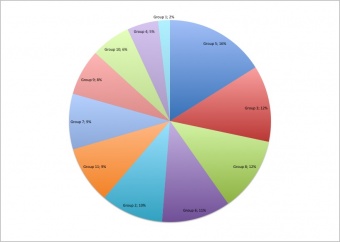
|
| All Project page edits by Group | All Discussion page edits by Group |
Training Tutorials
The following collapsed tables provide starting points for students during project work, you also have tutorials built into practical classes and practice exercises for individual assessmet items.
| 1. Working online |
|---|
| Students are first provided a 1 page how to edit a Wik document. This is followed by students setting up their own page and practicing basic editing. Finally they are shown the Help:Editing Basics page and linked resources. Important to explain that the early project should be about researching the topic rather than getting the layout correct. 2011 Students |
| 2. Referencing |
|---|
 First Read the help page Referencing First Read the help page Referencing
All references used in making your project page should be cited where they appear in the text or images. In page edit mode where XXXX is the PubMed ID number use the following code.
For references not listed on PubMed, and text can be inserted between <ref></ref> tags. Where the reference list will appear make a new section and on a new line the following code. <references/> |
| 3. Uploading Images |
|---|
 First Read the help page Images First Read the help page Images
A tutorial will be provided towards the end of the lab in uploading images. The image must first be uploaded to the site.
Images not including the above information will be deleted by the course coordinator and be considered in the student assessment process. Students cannot delete uploaded images. Contact the course coordinator with the file address. |
Literature Researching Strategies
- Identify key resource journals - content use.
- Key concepts.
- Historic vs current research topics.
- Outside of the research literature - textbooks, research laboratories, other resources.
Copyright
Copyright Tutorial | For Students
Plagiarism
Student Advice
Currently all students originally assigned to each group are listed as equal authors/contributors to their project. If you have not contributed the content you had originally agreed to, nor participated in the group work process, then you should contact the course coordinator immediately and either discuss your contribution or request removal from the group author list. Remember that all student online contributions are recorded by date, time and the actual contributed content. A similar email reminder of this information was sent to all current students.
Please note the Universities Policy regarding Plagiarism
In particular this example:
- "Claiming credit for a proportion of work contributed to a group assessment item that is greater than that actually contributed;"
Academic Misconduct carries penalties. If a student is found guilty of academic misconduct, the penalties include warnings, remedial educative action, being failed in an assignment or excluded from the University for two years.
Please also read Copyright Tutorial with regard to content that can be used in your project.
| About Plagiarism |
|---|
 Plagiarism is often about the Plagiarism is often about the
|
Peer Assessment
Student Advice
ANAT2341 Embryology Lab 8 - Online Assessment | ANAT2341 Cell Biology Lab 8 - Online Assessment
Individual assessment this week relates to your group project.
- Each student should now look at each of the other Group projects in the class.
- Next prepare a critical assessment (should include both positive and negative issues) of each project using the project assessment criteria.
- This assessment should be pasted without signature on the top of the specific project's discussion page (minimum length 3-5 paragraphs/project).
- This critical assessment should also be pasted on your own student page. Each student should therefore have 5 separate reports pasted on their own page for this assessment item. Length, quality and accuracy of your reports will be part of the overall mark for this assessment (there will be a greater loading on this than simple question assessments).
Student Example: Cell Biology | Embryology
| About Peer Assessment |
|---|

At about the 75% stage of the project an important process in learning occurs, this is when individual students assess other student groups.The assessment is short requiring "only prepare 3-5 paragraphs/project". In the previous lab the course coordinator had carried out a similar brief verbal assessment overview of how each project was developing. In the lab where the assessment is set the students are also given advice as to how to provide a "balanced assessment", including both strengths and weaknesses (positive and negative) in their comments. The entire class comments are made available to each group (on the discussion page of each project). Importantly all students have now read all projects and can see what their peers have done in preparing other projects and how their own project compares. This process also does some of the initial critical assessment/feedback that the coordinator would have previously done. The individual process though requires:
The group process requires:
2012 Students: Embryology Students - see Lab 8 Assessment Cell Biology Students - see Lab 9 Assessment |
| Group Assessment Criteria |
|---|
The assessment criteria was based upon those designed for the Medicine student Wikis.
|
Concluding Remarks
I hope from this presentation you can see what is required to make online group projects really work. This includes a gradual evolution of timelines, ongoing feedback strategies and realistic student goals.
Key identified components have been:
- Tutorials that are well structured both online and in-class.
- Monitoring groups how they are progressing and providing feedback.
- Monitoring individuals how each member in a group is contributing.
- Peer assessment allowing students to assess others work and then allowing groups to improve their final submission based upon this process.
Given the brief time available for this presentation, I would suggest that you open the various collapsed tables and links shown on this current page for reading in your own time.
Links
- Online Projects
- ANAT2341 Embryology Projects 2009 - 2012
- ANAT3231 Cell Biology Projects 2009 - 2012
- 2012 Learning & Teaching Seminar
- Site Map Education
External Links
Glossary Links
- Glossary: A | B | C | D | E | F | G | H | I | J | K | L | M | N | O | P | Q | R | S | T | U | V | W | X | Y | Z | Numbers | Symbols | Term Link
Cite this page: Hill, M.A. (2024, April 25) Embryology Medicine Learning and Teaching Forum 2012 - Online Projects. Retrieved from https://embryology.med.unsw.edu.au/embryology/index.php/Medicine_Learning_and_Teaching_Forum_2012_-_Online_Projects
- © Dr Mark Hill 2024, UNSW Embryology ISBN: 978 0 7334 2609 4 - UNSW CRICOS Provider Code No. 00098G
